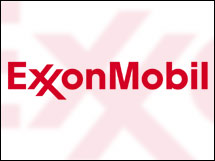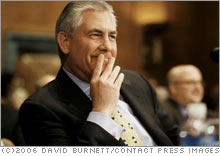|
Exxon's challenge: topping itself It's the most powerful U.S. corporation by almost any metric. But is it powerful enough to boost output by 5 percent a year in a world with less and less easy oil?
NEW YORK (FORTUNE) -- The world's biggest company is also a very big target. Even as it battles environmental critics and political opponents, Exxon (which leads this year's Fortune 500), is fighting hard to please Wall Street analysts, boost profits even further and increase its already staggering level of oil and gas production. With $339.9 billion in revenue and profits of $36.1 billion, Exxon earned more than any U.S. company in history last year -- more than the profits of the next four companies on the FORTUNE 500 combined. Exxon's return to No. 1 caps its emergence as not only the biggest but also the most powerful U.S. corporation by just about any metric. (This is an excerpt from a story in the April 17 issue of FORTUNE. To read the complete story, click here or go to www.fortune.com.)
Last year, Exxon surpassed General Electric to become the most valuable U.S. company by market capitalization ($375 billion). It pumps almost twice as much oil and gas a day as Kuwait, and its energy reserves stretch across six continents and are larger than those of any nongovernment company on the planet. This year, Wall Street expects it to spend nearly $15 billion on exploration and production, buy back roughly $15 billion in stock, and pay $7 billion in dividends, all without having to raid a cash hoard that exceeds $30 billion. The biggest challenge for Rex Tillerson, Exxon's new CEO, will be fulfilling Exxon's promise to increase output from 4.1 million barrels a day to five million by 2009. As analyst Paul Sankey of Deutsche Bank notes, that implies production gains of 4 percent to 5 percent annually, which Exxon has fallen far short of in recent years. If Exxon can't do that, future earnings growth will depend mostly on oil prices continuing to rise -- something Tillerson doesn't think likely. The Sisyphean effort to replace reserves and boost already staggering production levels is a challenge Exxon shares with other supermajors. But while Exxon's $30 billion in cash and its AAA-rated balance sheet would allow Tillerson to add reserves by buying a smaller company -- as Chevron did with Unocal last year -- its disciplined approach to using capital means he would rather wait until oil prices come down before doing a deal. "I'm not sure it makes sense in this environment to make a major acquisition," he says. "When I look at some of the transactions that have occurred, they seem rather pricey to me." That kind of patience has a way of paying off: Former Exxon CEO Lee Raymond bought Mobil just as oil prices bottomed out in 1998. To grow without acquiring smaller companies, Tillerson's going to need all the negotiating skills he's known for, because the keys to increasing Exxon's output lie in some of the world's most difficult places. In the 1990s, Tillerson won notice as a skilled dealmaker when he led talks with the Russian government to develop oil and gas fields off Sakhalin Island, an area expected to contribute 250,000 barrels a day in new production by the end of 2006. "He's the best negotiator I've ever seen," says Eugene Lawson, president of the U.S.-Russia Business Council, of which Tillerson is a board member. Besides Russia, the company is counting on volatile Nigeria and Angola to contribute nearly one million barrels of new production by the end of 2010. In Venezuela, where Exxon has invested billions to turn tar-sand into crude, the company finds itself in a standoff with Hugo Chávez. The Venezuelan president has forced other companies to renegotiate their deals and pay more in royalties, but Exxon isn't budging. If negotiations fail, it could be forced out. This is an excerpt from a story in the April 17 issue of FORTUNE. To read the complete story, click here or go to www.fortune.com. |
|


